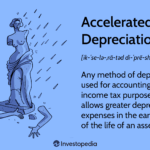What Is Accumulated Depreciation?
Accumulated depreciation is the cumulative depreciation of an asset up to a single point in its life. Accumulated depreciation is a contra asset account, meaning its natural balance is a credit that reduces the overall asset value.
Key Takeaways
- Depreciation is recorded to tie the cost of using a long-term capital asset with the benefit gained from its use over time.
- Accumulated depreciation is the sum of all recorded depreciation on an asset to a specific date.
- Accumulated depreciation is presented on the balance sheet just below the related capital asset line.
- Accumulated depreciation is recorded as a contra asset that has a natural credit balance (as oppose to asset accounts with natural debit balances).
- The carrying value of an asset is its historical cost minus accumulated depreciation.
Understanding Accumulated Depreciation
The matching principle under generally accepted accounting principles (GAAP) dictates that expenses must be matched to the same accounting period in which the related revenue is generated. Through depreciation, a business will expense a portion of a capital asset’s value over each year of its useful life. This means that each year a capitalized asset is put to use and generates revenue, the cost associated with using up the asset is recorded.
Accumulated depreciation is the total amount an asset has been depreciated up until a single point. Each period, the depreciation expense recorded in that period is added to the beginning accumulated depreciation balance. An asset’s carrying value on the balance sheet is the difference between its historical cost and accumulated depreciation. At the end of an asset’s useful life, its carrying value on the balance sheet will match its salvage value.
When recording depreciation in the general ledger, a company debits depreciation expense and credits accumulated depreciation. Depreciation expense flows through to the income statement in the period it is recorded. Accumulated depreciation is presented on the balance sheet below the line for related capitalized assets. The accumulated depreciation balance increases over time, adding the amount of depreciation expense recorded in the current period.
Accumulated depreciation is dependent on salvage value; salvage value is determined as the amount a company may expect to receive in exchange for selling an asset at the end of its useful life.
How to Calculate Accumulated Depreciation
There are several acceptable methods for calculating depreciation. These methods are allowable under Generally Accepted Accounting Principles (GAAP). A company may select the depreciation method they wish to use.
Straight-Line Method
Under the straight-line method of accounting, a company deducts the asset’s salvage value from the purchase price to find a depreciable base. Then, this base is accumulated evenly over the anticipated useful life of the asset. The straight-line method formula is:
Annual Accumulated Depreciation = (Asset Value – Salvage Value) / Useful Life in Years
Imagine Company ABC buys a building for $250,000. The building is expected to be useful for 20 years with a value of $10,000 at the end of the 20th year. The depreciable base for the building is $240,000 ($250,000 – $10,000). Divided over 20 years, the company would recognized $20,000 of accumulated depreciation every year.
Declining Balance Method
Under the declining balance method, depreciation is recorded as a percentage of the asset’s current book value. Because the same percentage is used in every year while the current book value decreases, the amount of depreciation decreases each year. Even though accumulated depreciation will still increase, the amount of accumulated depreciation will decrease each year.
Annual Accumulated Depreciation = Current Book Value * Depreciation Rate
For example, imagine Company ABC buys a company vehicle for $10,000 with no salvage value at the end of its life. The company decided it would depreciate 20% of the book value each year. In Year 1, Company ABC would recognize $2,000 ($10,000 * 20%) of depreciation and accumulated depreciation. In Year 2, Company ABC would recognize $1,600 (($10,000 – $2,000) * 20%).
Double-Declining Balance Method
Under the double-declining balance (also called accelerated depreciation), a company calculates what it’s depreciation would be under the straight-line method. Then, the company doubles the depreciation rate, keeps this rate the same across all years the asset is depreciated, and continues to accumulate depreciation until the salvage value is reached. The percentage can simply be calculated as twice of 100% divided by the number of years of useful life.
Double-Declining Balance Method Rate = (100% / Useful Life In Years) * 2
Double-Declining Balance Method = Depreciable Amount * Double-Declining Balance Method Rate
Let’s imagine Company ABC’s building they purchased for $250,000 with a $10,000 salvage value. Under the straight-line method, the company recognized 5% (100% depreciation / 20 years); therefore, it would use 10% as the depreciation base for the double-declining balance method. The company would recognize $24,000 ($240,000 depreciable base * 10%) in Year 1, and would recognize $21,600 (($240,000 depreciable base – $24,000) * 10%).
Sum-of-the-Years’ Digits Method
Under the sum-of-the-years’ digits method, a company strives to record more depreciation earlier in the life of an asset and less in the later years. This is done by adding up the digits of the useful years, then depreciating based on that number of year.
Annual Accumulated Depreciation = Depreciable Base * (Inverse Year Number / Sum of Year Digits)
Company ABC purchased a piece of equipment that has a useful life of 5 years. The asset has a depreciable base of $15,000. Since the asset has a useful life of 5 years, the sum of year digits is 15 (5+4+3+2+1). The depreciation rate is then the quotient of the inverse year number (Year 1 = 5, Year 2 = 4, Year 3 = 3, etc.) divided by 15. In Year 1, the company will recognize $5,000 ($15,000 * (5/15)) of depreciation and will recognize $4,000 ($15,000 * (4/15)) in Year 2.
Units of Production Method
Under the units of production method, a company estimates the total useful output of an asset. Then, the company evaluates how many of those units were consumed each year to recognize accumulated depreciation variably based on use. The formula for the units of production method is:
Annual Accumulated Deprecation = (Number of Units Consumed / Total Units To Be Consumed) * Depreciable Base
For example, a company buys a company vehicle and plans on driving the vehicle 80,000 miles. In the first year, the company drove the vehicle 8,000 miles. Therefore, it would recognize 10% (8,000 / 80,000) of the depreciable base. In the second year, if the company drives 20,000 miles, it would recognize 25% of depreciable base as an expense in the second year, with accumulated depreciation now equal to $28,000 ($8,000 in the first year + $20,000 in the second year).
Accumulated Depreciation vs. Accelerated Depreciation
Though similar sounding in name, accumulated depreciation and accelerated depreciation refer to very different accounting concepts. Accumulated depreciation refers to the life-to-date depreciation that has been recognized that reduces the book value of an asset. On the other hand, accelerated depreciation refers to a method of depreciation where a higher amount of depreciation is recognized earlier in an asset’s life.
Since accelerated depreciation is an accounting method for recognizing depreciation, the result of accelerated depreciation is to book accumulated depreciation. Under this method, the amount of accumulated depreciation accumulates faster during the early years of an asset’s life and accumulates slower later. The philosophy behind accelerated depreciation is assets that are newer (i.e. a new company vehicle) are often used more than older assets because they are in better condition and more efficient.
Accumulated depreciation is a real account (a general ledger account that is not listed on the income statement). The balance rolls year-over-year, while nominal accounts like depreciation expense are closed out at year end.
Accumulated Depreciation vs. Depreciation Expense
When an asset is depreciated, two accounts are immediately impacted: accumulated depreciation and depreciation expense. The journal entry to record depreciation results in a debit to depreciation expense and a credit to accumulated depreciation. The dollar amount for each line is equal to the other.
There are two main differences between accumulated depreciation and depreciation expense. First, depreciation expense is reported on the income statement, while accumulated depreciation is reported on the balance sheet.
Second, on a related note, the income statement does not carry from year-to-year. Activity is swept to retained earnings, and a company “resets” its income statement every year. Meanwhile, its balance sheet is a life-to-date running total that does not clear at year-end. Therefore, depreciation expense is recalculated every year, while accumulated depreciation is always a life-to-date running total.
Special Considerations
Accounting Adjustments/Changes in Estimate
Because the depreciation process is heavily rooted with estimates, it’s common for companies to need to revise their guess on the useful life of an asset’s life or the salvage value at the end of the asset’s life. This change is reflected as a change in accounting estimate, not a change in accounting principle. For example, say a company was depreciating a $10,000 asset over its five year useful life with no salvage value. Using the straight-line method, accumulated depreciation of $2,000 is recognized.
After two years, the company realizes the remaining useful life is not three years but instead six years. Under GAAP, the company does not need to retroactively adjust financial statements for changes in estimates. Instead, the company will change the amount of accumulated depreciation recognized each year.
In this example, since the asset now has a $6,000 net book value ($10,000 purchase price less $4,000 of accumulated depreciation booked in the first two years), the company will now recognized $1,000 of accumulated depreciation for the next six years.
Half-Year Recognition
A commonly practiced strategy for depreciating an asset is to recognize a half year of depreciation in the year an asset is acquired and a half year of depreciation in the last year of an asset’s useful life. This strategy is employed to more fairly allocate depreciation expense and accumulated depreciation in years when an asset may only be used part of a year.
For example, Company A buys a company vehicle in Year 1 with a five year useful life. Regardless of the month, the company will recognize six months worth of depreciation in Year 1. The company will also recognize a full year of depreciation in Year 2 – 5. Then, the company will recognize the final half year of depreciation in Year 6. Although the asset only had a useful life of five years, it is argued that the asset wasn’t used for the entirety of Year 1 nor the entirety of Year 6.
Example of Accumulated Depreciation
Company A buys a piece of equipment with a useful life of 10 years for $110,000. The equipment is estimated to have a salvage value of $10,000. The equipment is going to provide the company with value for the next 10 years, so the company expenses the cost of the equipment over the next 10 years. Straight-line depreciation is calculated as (($110,000 – $10,000) / 10), or $10,000 a year. This means the company will depreciate $10,000 for the next 10 years until the book value of the asset is $10,000.
Each year the contra asset account referred to as accumulated depreciation increases by $10,000. For example, at the end of five years, the annual depreciation expense is still $10,000, but accumulated depreciation has grown to $50,000. That is, accumulated depreciation is a cumulative account. It is credited each year as the value of the asset is written off and remains on the books, reducing the net value of the asset, until the asset is disposed of or sold. It is important to note that accumulated depreciation cannot be more than the asset’s historical cost even if the asset is still in use after its estimated useful life.
Is Accumulated Depreciation an Asset?
Accumulated depreciation is a contra asset that reduces the book value of an asset. Accumulated depreciation has a natural credit balance (as opposed to assets that have a natural debit balance). However, accumulated depreciation is reported within the asset section of a balance sheet.
Is Accumulated Depreciation a Current Liability?
Accumulated depreciation is not a liability. A liability is a future financial obligation (i.e. debt) that the company has to pay. Accumulation depreciation is not a cash outlay; the cash obligation has already been satisfied when the asset is purchased or financed. Instead, accumulated depreciation is the way of recognizing depreciation over the life of the asset instead of recognizing the expense all at once.
How Do You Calculate Accumulated Depreciation?
Accumulated depreciation is calculated using several different accounting methods. Those accounting methods include the straight-line method, the declining balance method, the double-declining balance method, the units of production method, or the sum-of-the-years method. In general, accumulated depreciation is calculated by taking the depreciable base of an asset and dividing it by a suitable divisor such as years of use or units of production.
Where Is Accumulated Depreciation Recorded?
Accumulated depreciation is recorded as a contra asset via the credit portion of a journal entry. Accumulated depreciation is nested under the long-term assets section of a balance sheet and reduces the net book value of a capital asset.
Is Accumulated Depreciation a Credit or Debit?
Accumulated depreciation is a natural credit balance. Although it is reported on the balance sheet under the asset section, accumulated depreciation reduces the total value of assets recognized on the financial statement since assets are natural debit accounts.
The Bottom Line
Many companies rely on capital assets such as buildings, vehicles, equipment, and machinery as part of their operations. In accordance with accounting rules, companies must depreciate these assets over their useful lives. As a result, companies must recognize accumulated depreciation, the sum of depreciation expense recognized over the life of an asset. Accumulated depreciation is reported on the balance sheet as a contra asset that reduces the net book value of the capital asset section.



